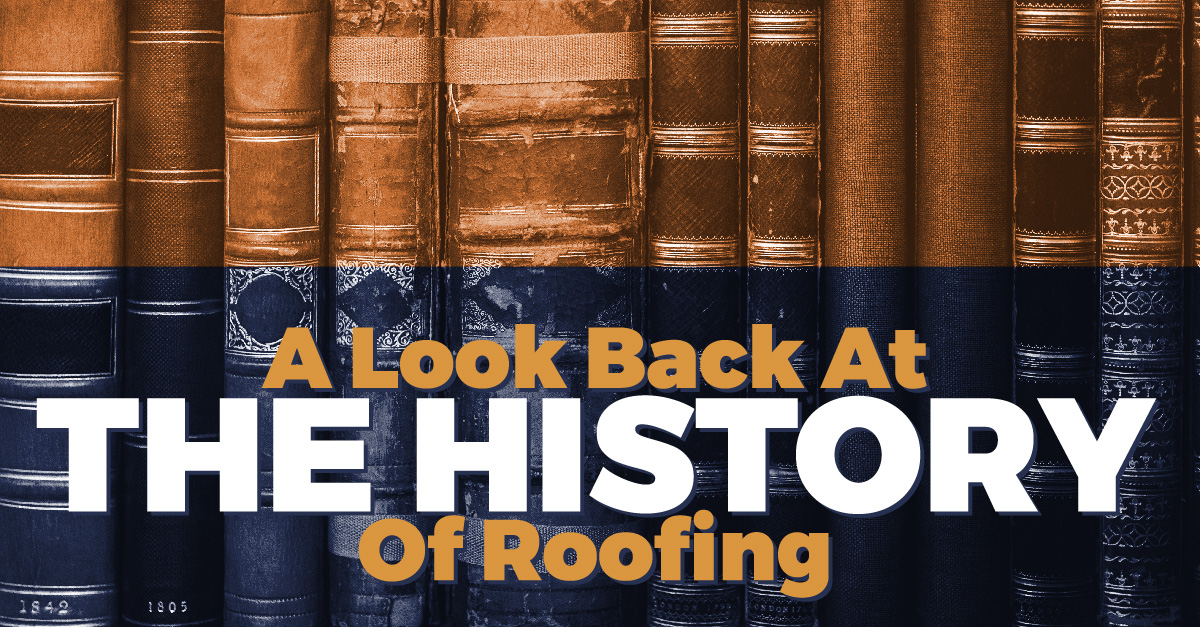A Look Back At The History Of Roofing

Think of any American natural resource. If we cannot grow or harvest it, we must mine it. Over hundreds of years of inventiveness, innovation, and hard work, Americans have found ingenious ways to roof and protect our homes and businesses. We have grown trees to turn into wood shakes, mined and cleaved slate, quarried and smelted copper, and fired clay tiles in vast kilns.
Humility
The first American roofing materials were whatever the local people could find. Tree bark, animal skins, thin saplings overlaid with thatch — these makeshift, humble roofs were rife with rodents and insects, were seldom completely waterproof, and did not last long.
From simple beginnings, Native Americans and settlers alike organized and improved their roofs by standardizing the individual pieces. Whether drying and firing flat clay tiles or splitting individual cedar shakes, home builders increased efficiency and reduced waste by creating hand-held pieces. Some talented builders began specializing in residential and commercial roofing.
Individual settlers or farmers no longer had to be jacks-of-all-trades. They could look to roofing contractors who knew their craft and had the right tools and talents for laying down shakes, native metal roofing, or barrel or flat tiles.
Slate
Slate is a sedimentary rock which cleaves, or breaks apart, very easily. It is fireproof, can be shaped into standard pieces, and can be drilled for nail holes. It is also very heavy, so roofs built to take a slate roof were substantial (and expensive). Slate has capped everything from castles to commercial buildings for hundreds of years.
Only after the expansion of railroads did slate roofing catch on as a viable, affordable roofing material to be bought and sold throughout the United States. It was simply too heavy to economically ship by wagon, so if your area of the country lacked slate quarries, you did not get a slate roof. You relied instead on wood.
Shingles and Shakes
Wood was the natural choice of European settlers from New England to Florida. Before the middle of the 19th century, hand-split shakes were made from whatever local wood was available (yellow pine in the south, cypress in Florida, cedar just about everywhere). The weather resistance of cedar made it one of the earliest roofing commodities, shipped by wagon or rail around the country.
From the 1840s onward, portable sawmills made sawn shingles common and affordable. Half a century later, with the Northwest’s redwoods accessible by a railroad-crossed nation, rot-resistant redwood shingles overtook the market.
Oops
For a while in the 1920s and 1930s, composite roofing of cement and (brace yourself) asbestos were popular and affordable choices in roofing materials. Fortunately, asbestos-cement shingles are seldom found today.
Kit Built
The early to middle part of the 20th century saw the innovation of kit-built homes sold by Sears Roebuck straight from their catalog. These homes came with stamped, pre-cut framing members, interior and exterior moldings, and shingles. Sears kit homes were built with the finest materials (cypress; first-growth, top-grade southern yellow pine for framing members; kitchen and bath floors of solid maple), including options for roofs of either wood shingles or “Fire-Chief Shingle roll roofing.” Not bad for an $825 home!
Industrial Ingenuity
In many ways, the maximum size of industrial buildings was limited by the size of the roof. Before the development of rolled materials which could be seamed together, residential and industrial buildings alike had to be covered in unitized pieces, like split cedar shakes or heavy slate. These all needed steep slopes to allow for proper drainage, so even the largest warehouse had a roof interrupted by many peaks, valleys, and gables.
The ingenious development of built-up roofing (BUR) in the late 1890s, says Architect Magazine, transformed the actual shape of commercial properties, setting the stage for zoning changes, distinct neighborhoods, and increased productivity in “industrial zones.”
Make it Metal
Europeans brought centuries-old metalworking skills to America’s shores, forming lead sheets and copper pieces into low-slope roofing soldered together on site. Later, say experts at Period Homes, standing seam metal roofing became dominant for commercial buildings, farm structures, and the occasional residential risk-taker.
In the 21st century beautiful metal roofing is recognized for its durability and economy in residential homes throughout America. In earlier times, terne metal and galvanized steel were associated with unsightly but long-lasting outbuildings and factory roofs.
Historical Roofing
Any historic home or business needs a roofer with experience in dealing with all types of historical roofing, from early wood to mid-century metal. If you are fortunate enough to have a home or business which played a historic role in America, contact us at Stevens Roofing Corporation for expert historical roof repair and maintenance. We have years of experience in caring for historical roofing. We know what is at stake in preserving, restoring and repairing your historical roofing.


